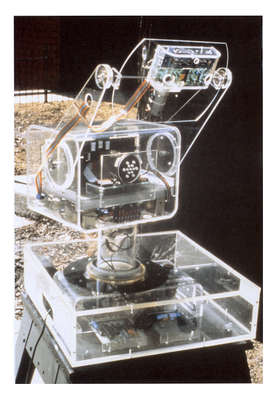White’s art is often defined as ”electronic art” and therefore not linked to computer art, but he is one of those artists who have employed computers in an outstanding way in his complete ceuvre and have developed a special artistic understanding of the computer’s genuine possibilities
As from 1976 Norman White transfer his first manual electronic work to immaterial software, in other words in his own programming. But it is seldom visible in his artworks. It remains concealed in complex machines, which use the possibilities of the computer in their turn for the independent organisation and further development of the basic creative setup. White’s machines act, react and learn – and so it is logical that robots are his most decisive art form today. (Herzogenrath & Lähnemann 2009:7)
The first machine that was made on the basis of computer programming and also displayed the characteristics of a robot is Facing Out Laying Low.
It is also a good example of White’s open work concept, for since its initial production in 1977 it was further developed and adapted according to the relevant new technical possibilities. It does not belong to the category of an original, completed, autonomous work, but can be seen as an investigation into a specific pattern of behaviour, which is represented as a reaction to its immediate surroundings in this case.
The first version could only ”see” in one direction and only move independently within limitations; it could turn on its own axis. By means of a light sensor, it registered changes in the room and expressed its ”pleasure” over them by means of a whistling noise, which intensified according to its growing enthusiasm. In later versions, the machine was developed further so that it followed any people that it noticed in the room. It is best described as a rather pushy personification of curiosity. Facing Out Laying Low is an independent work that stimulates interaction on the part of its recipents because it is oriented on their behaviour, but it is not yet an ”interactive work”. (Herzogenrath & Lähnemann 2009:23f.)
The artist by himself describes the work as a microcomputer-controlled, interactive robot. It surveys its surroundings from a fixed point, and responds to activity it finds “interesting” with a variety of audio responses (the first version employed coded brownian trills, while later versions used synthesized voice). It has gone through six major hardware/software revisions, the most recent being a complete hardware/software re-build after the original work went missing.
[http://www.normill.ca/artpage.html] (consulted 27.10.09)
If you’d like to see the program (in Motorola 6800 Assembler) which gave the original F.O.L.L. its particular behaviour, follow the link
[http://www.normill.ca/Text/f4e2-lon.txt]




